Nicole schreibt...
Valencia 2016 |
 |
 Once upon a time I had the grand plan to visit one Spanish town per year as I had found that there's so much more to Spain than the boozy islands and costas of the middle european tourist hordes. But nothing much came of that as the world is simply too big and interesting. Now I was finally back though and this time to visit Valencia, Spain's third-biggest town and one of the few places not yet fully overrun by the hordes that blight Barcelona and the towns further south.
Even just getting there proved to be a bit difficult and resulted in having to fly there on Eurowings from godawful Düsseldorf Airport (and coming back to Cologne on Ryanair later). At least everything went well and flight included a panoramic view over Paris from a cloudless sky. The surprisingly small airport of Valencia is directly connected to the city by cheap, clean and efficient metro which took us to Alameda station, two minutes' walk from our hotel, the fancy Palau de le Mar which was converted from some noblemanm's palace to a gorgeous boutique hotel.
Once upon a time I had the grand plan to visit one Spanish town per year as I had found that there's so much more to Spain than the boozy islands and costas of the middle european tourist hordes. But nothing much came of that as the world is simply too big and interesting. Now I was finally back though and this time to visit Valencia, Spain's third-biggest town and one of the few places not yet fully overrun by the hordes that blight Barcelona and the towns further south.
Even just getting there proved to be a bit difficult and resulted in having to fly there on Eurowings from godawful Düsseldorf Airport (and coming back to Cologne on Ryanair later). At least everything went well and flight included a panoramic view over Paris from a cloudless sky. The surprisingly small airport of Valencia is directly connected to the city by cheap, clean and efficient metro which took us to Alameda station, two minutes' walk from our hotel, the fancy Palau de le Mar which was converted from some noblemanm's palace to a gorgeous boutique hotel.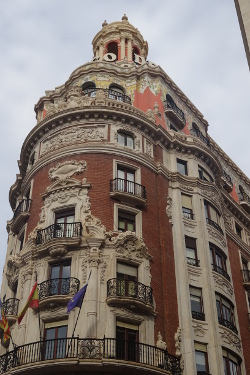 Since it was too late to head for the beach, we spent a while in the small hotel spa before heading for our first walk into town, passing La Glorieta arch, which is crowned by one of Valencia's numerous bats. There are a few conflicting stories how the city came by a bat as its symbol, the most popular one being that a bat helped King James I. of Aragon to win Valencia back from the Moors. Not a legend is the fact that DC Comics tried to sue Valencia FC about their bat logo, claiming that they had a trademark on bats because of Batman. Luckily Valencia could tell them where to stick it (having had the logo since 1919 before Batman was even a thing).
Our first wander took us past many pretty buildings like the one on the left (the main building of the Banco de Valencia) and the Plaça de l'Ajuntament (for the sake of coherence, I'll stick with the Valencian Catalan for all the names) with the town hall (left). This is also where the main act of the "Fallas" goes down, Valencia's famous spring festival. Finally we ended up in a lovely little pedestrian alley where we could stuff ourselves on tapas.
Since it was too late to head for the beach, we spent a while in the small hotel spa before heading for our first walk into town, passing La Glorieta arch, which is crowned by one of Valencia's numerous bats. There are a few conflicting stories how the city came by a bat as its symbol, the most popular one being that a bat helped King James I. of Aragon to win Valencia back from the Moors. Not a legend is the fact that DC Comics tried to sue Valencia FC about their bat logo, claiming that they had a trademark on bats because of Batman. Luckily Valencia could tell them where to stick it (having had the logo since 1919 before Batman was even a thing).
Our first wander took us past many pretty buildings like the one on the left (the main building of the Banco de Valencia) and the Plaça de l'Ajuntament (for the sake of coherence, I'll stick with the Valencian Catalan for all the names) with the town hall (left). This is also where the main act of the "Fallas" goes down, Valencia's famous spring festival. Finally we ended up in a lovely little pedestrian alley where we could stuff ourselves on tapas.
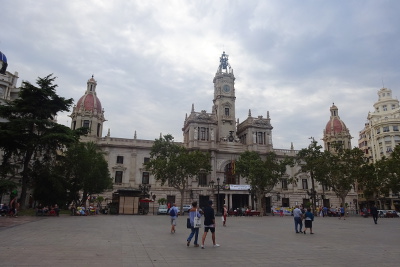
|
 |
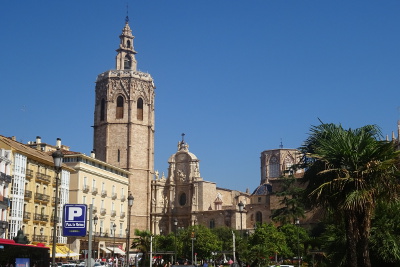
|
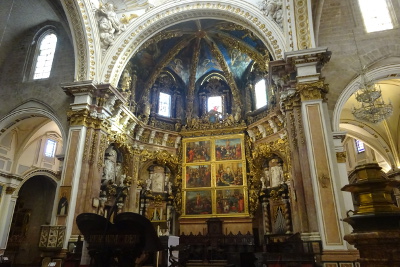 |
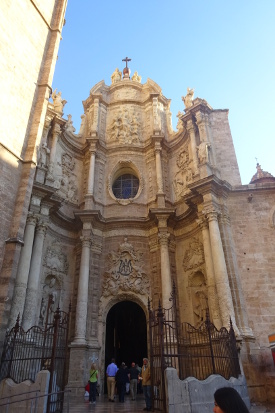 |
 |
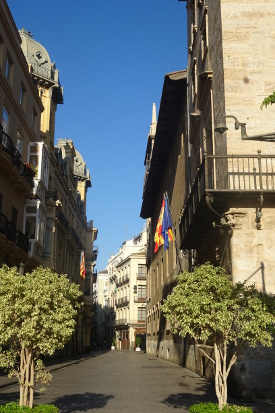 |
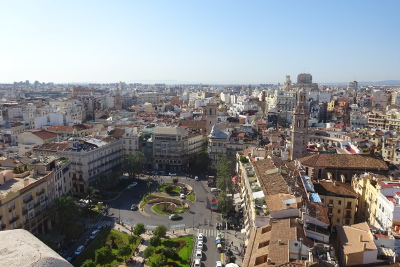
|
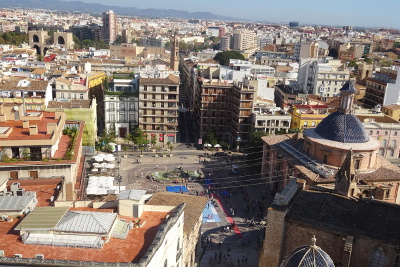 |
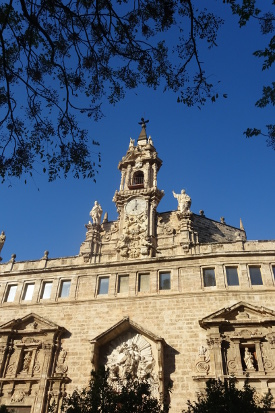 From the cathedral we walked on to the splendid church of Sant Joans and the Mercat Central, the central market which is really still a functioning market for fish, meat, vegetables and more and not just a tourist trap. Notice all the yummy Jamon Iberico everywhere! I was sorely tempted to buy one of the paella pans but remembered in time that Ryanair doesn't respond kindly to excess baggage.
Across the street is Valencia's other famous sight, the gothic Llotja de la Seda, which is now an UNESCO world heritage site. Built in late 15th century it was the meeting hall for silk merchants who convened here to trade their exotic goods. There isn't really much to see now except the main trading hall with its amazing high rising pillars and the Tribunal del Mar, the first Spanish merchant tribunal to be formed. Merchants who defaulted on bills or otherwise couldn't pay up were unceremoniously tossed into the prison that's still to be seen in the basement.
After our tour of the Old City we took the metro and tram to Valencia's gorgeous endless beach - still much of a hidden gem.
From the cathedral we walked on to the splendid church of Sant Joans and the Mercat Central, the central market which is really still a functioning market for fish, meat, vegetables and more and not just a tourist trap. Notice all the yummy Jamon Iberico everywhere! I was sorely tempted to buy one of the paella pans but remembered in time that Ryanair doesn't respond kindly to excess baggage.
Across the street is Valencia's other famous sight, the gothic Llotja de la Seda, which is now an UNESCO world heritage site. Built in late 15th century it was the meeting hall for silk merchants who convened here to trade their exotic goods. There isn't really much to see now except the main trading hall with its amazing high rising pillars and the Tribunal del Mar, the first Spanish merchant tribunal to be formed. Merchants who defaulted on bills or otherwise couldn't pay up were unceremoniously tossed into the prison that's still to be seen in the basement.
After our tour of the Old City we took the metro and tram to Valencia's gorgeous endless beach - still much of a hidden gem.
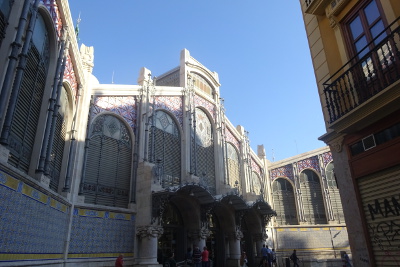
|
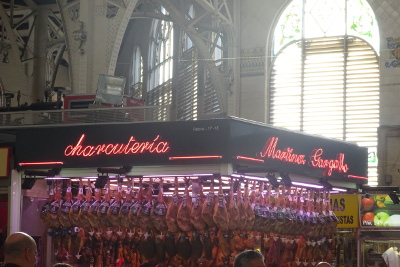 |

|
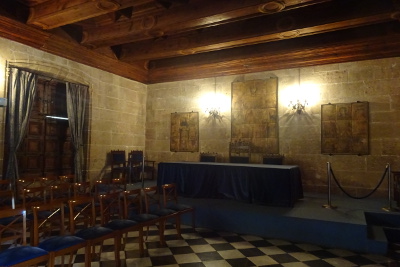 |
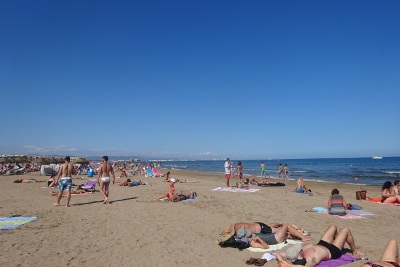 Valencia has (much like Barcelona) always lived "with their backs to the sea", meaning that they didn't care for the nearby sea or the port. While the port got smartened up very much for the America's Cup in 2003 (won by land-locked Switzerland, ironically, for which Valencia became substitute) the nearby quarter of Cabanyal is still pretty much a rough and worn down fishing village lined by the long Platja Les Arenes that soon becomes the Platja Malva Rosa. I hope for Cabanyal's sake that it may long remain as it is now and not suffer the same fate as Barcelona's sea-facing fishing district La Barceloneta which got gentrified and AirBnB'ed in recent years to a point that residents just want to throw all tourists out. Anyway, while it was interesting to see Valencia and realize it is now how Barcelona was before it got loved to death, I was mostly keen on finally flopping on a sandy beach and swim in the lovely Mediterranean.
Valencia has (much like Barcelona) always lived "with their backs to the sea", meaning that they didn't care for the nearby sea or the port. While the port got smartened up very much for the America's Cup in 2003 (won by land-locked Switzerland, ironically, for which Valencia became substitute) the nearby quarter of Cabanyal is still pretty much a rough and worn down fishing village lined by the long Platja Les Arenes that soon becomes the Platja Malva Rosa. I hope for Cabanyal's sake that it may long remain as it is now and not suffer the same fate as Barcelona's sea-facing fishing district La Barceloneta which got gentrified and AirBnB'ed in recent years to a point that residents just want to throw all tourists out. Anyway, while it was interesting to see Valencia and realize it is now how Barcelona was before it got loved to death, I was mostly keen on finally flopping on a sandy beach and swim in the lovely Mediterranean.
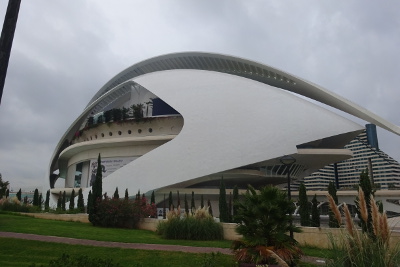 The most visible part of Valencia's overhaul in 2003 was the incredible "Ciutat de les Arts i les Ciencies", the City of Art and Science, plonked into the dry river bed of the Turia by local boy Santiago Calatrava, one of the world's most famous architects who really let rip here. I thought it would be fun to actually see something at the "Palau de les Arts Reina Sofia" the concert hall that contains four auditoriums inside and looks like the love child of an ufo and the Sydney Opera House. As luck would have it, they had a charity ballet gala going on where some of the best dancers of the Spanish National Ballet showed some highlights from classical and more modern ballets. It was a wonderful evening with no language bareer inside a truly beautiful venue that shows that even modern theatres can look great.
The most visible part of Valencia's overhaul in 2003 was the incredible "Ciutat de les Arts i les Ciencies", the City of Art and Science, plonked into the dry river bed of the Turia by local boy Santiago Calatrava, one of the world's most famous architects who really let rip here. I thought it would be fun to actually see something at the "Palau de les Arts Reina Sofia" the concert hall that contains four auditoriums inside and looks like the love child of an ufo and the Sydney Opera House. As luck would have it, they had a charity ballet gala going on where some of the best dancers of the Spanish National Ballet showed some highlights from classical and more modern ballets. It was a wonderful evening with no language bareer inside a truly beautiful venue that shows that even modern theatres can look great.
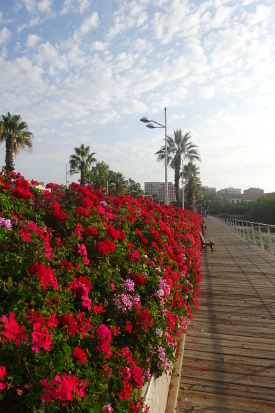 The next day (Sunday) was fully spent lazing around on the beach - something intended for the last day of the trip but the weather forecast decreed otherwise. In the evening we had the proper Valencian paella, which is done with chicken (or rabbit) and beans mixed into the rice - the "modern" seafood paella now widely seen as Spain's national dish was really just an invention for the tourists initially.
On Monday morning we returned to the Ciutat de les Arts i les Ciencies for a proper look, walking there along the Jardi del Turia, where once the Turia river wound its way to the sea. While often just a trickle, it would swell to an impressive size in spring after the snow in the mountains melted and in 1957 burst its banks so badly that most of the city was flooded. The Valencians then decided to simply ban the river from town - by digging a new riverbed on the other side of the city where it could run to the sea. Spains dictator Franco wanted to convert the old river bed into a city highway but luckily for Valencia the man died before his plan was realized - and instead a six kilometre long gorgeous park was created which is now crowned by Calatrava's masterpiece at the end. On the right is the beautiful "Bridge of Flowers" and below the walk through the former riverbed and now park:
The next day (Sunday) was fully spent lazing around on the beach - something intended for the last day of the trip but the weather forecast decreed otherwise. In the evening we had the proper Valencian paella, which is done with chicken (or rabbit) and beans mixed into the rice - the "modern" seafood paella now widely seen as Spain's national dish was really just an invention for the tourists initially.
On Monday morning we returned to the Ciutat de les Arts i les Ciencies for a proper look, walking there along the Jardi del Turia, where once the Turia river wound its way to the sea. While often just a trickle, it would swell to an impressive size in spring after the snow in the mountains melted and in 1957 burst its banks so badly that most of the city was flooded. The Valencians then decided to simply ban the river from town - by digging a new riverbed on the other side of the city where it could run to the sea. Spains dictator Franco wanted to convert the old river bed into a city highway but luckily for Valencia the man died before his plan was realized - and instead a six kilometre long gorgeous park was created which is now crowned by Calatrava's masterpiece at the end. On the right is the beautiful "Bridge of Flowers" and below the walk through the former riverbed and now park:

|
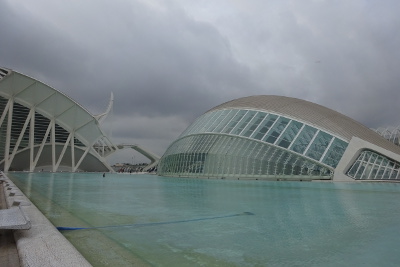 |
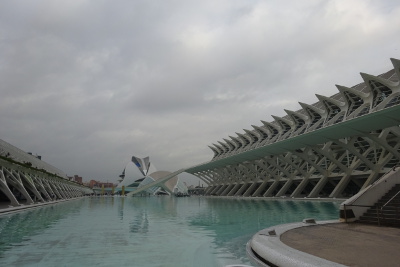
|
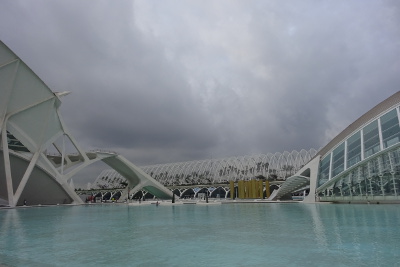 |
 The last part is L'Oceanografic, a huge aquarium where we spent nearly three hours looking at all sorts of marine life, some birds and some butterflies. While it was fairly pricey, I do think it was worth the price with its many area that covered all climate zones from the tropics to Antarctica and with exhibits from tiny clown fish to huge Beluga whales. Unfortunately one of the oversized cruise ships were in town, so the bane of my life, the cruise sheeple, trampled all over the aquarium in large groups which clogged up everything. Why it's so difficult to just take a cab to a sight and doing it on your own, audio guide in hand, is beyond me. Oh well, here are some pictures of the place and its inhabitants:
The last part is L'Oceanografic, a huge aquarium where we spent nearly three hours looking at all sorts of marine life, some birds and some butterflies. While it was fairly pricey, I do think it was worth the price with its many area that covered all climate zones from the tropics to Antarctica and with exhibits from tiny clown fish to huge Beluga whales. Unfortunately one of the oversized cruise ships were in town, so the bane of my life, the cruise sheeple, trampled all over the aquarium in large groups which clogged up everything. Why it's so difficult to just take a cab to a sight and doing it on your own, audio guide in hand, is beyond me. Oh well, here are some pictures of the place and its inhabitants:
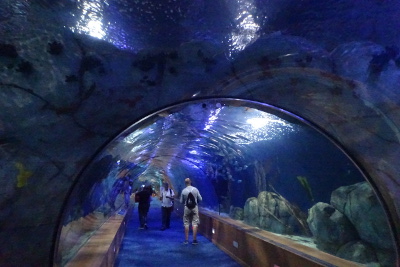
|
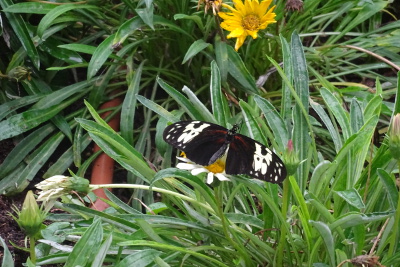 |
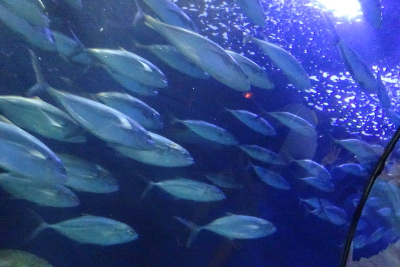
|
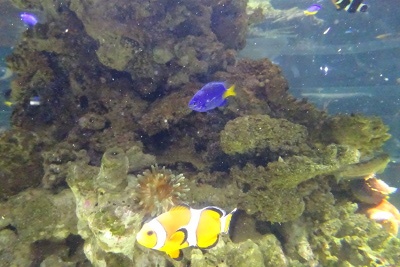 |
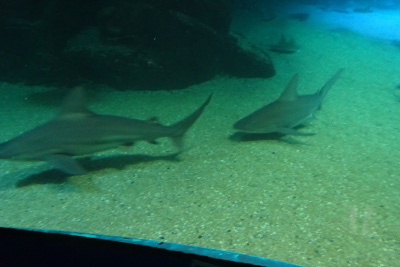
|
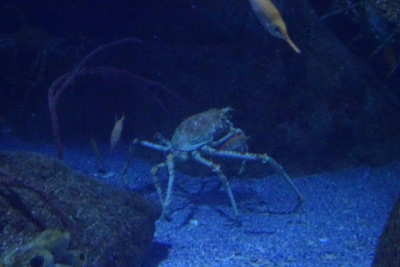 |
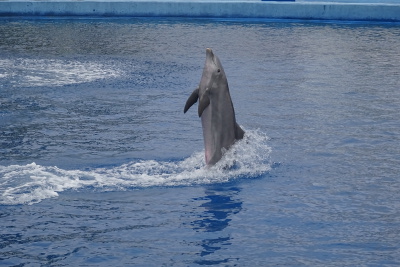
|
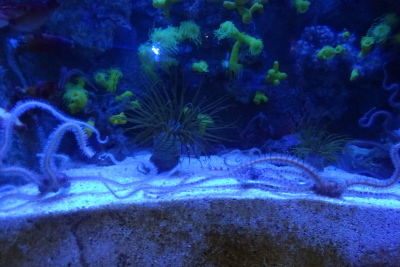 |
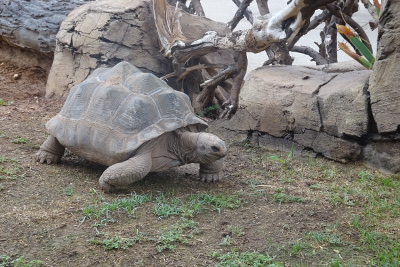
|
 |
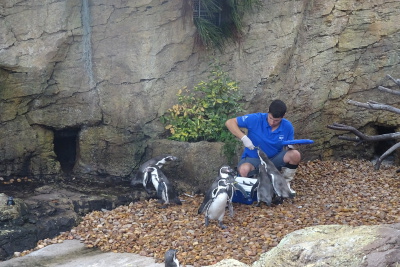
|
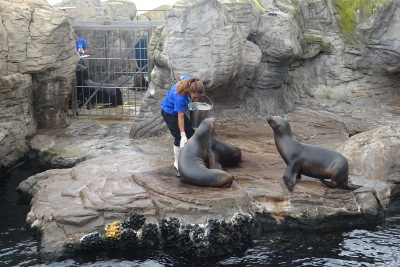 |
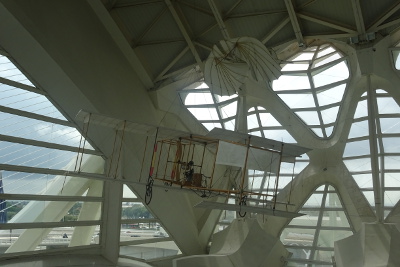 Not just the animals were hungry by the time we were done, so were we! Since the ticket was valid for the science museum as well, we walked there to have a quick lunch in the cafe and take a look around. It was all very modern and very interactive, inviting you to try out all sorts of scientific experiments and connecting science to regular life. I wish we had had stuff like that when I was still at school and the utterly tedious chemistry or physics lessons seemed to be completely disconnected from reality.
After the hours spent at the Oceanografic we didn't last very long though and were glad to hop on a bus back to the hotel. Nonetheless, the whole City of Arts and Sciences is an utter marvel that shows modern architecture can be both splendid and "for the people" and not just some giant waste of taxpayer money (hello Hamburg).
Not just the animals were hungry by the time we were done, so were we! Since the ticket was valid for the science museum as well, we walked there to have a quick lunch in the cafe and take a look around. It was all very modern and very interactive, inviting you to try out all sorts of scientific experiments and connecting science to regular life. I wish we had had stuff like that when I was still at school and the utterly tedious chemistry or physics lessons seemed to be completely disconnected from reality.
After the hours spent at the Oceanografic we didn't last very long though and were glad to hop on a bus back to the hotel. Nonetheless, the whole City of Arts and Sciences is an utter marvel that shows modern architecture can be both splendid and "for the people" and not just some giant waste of taxpayer money (hello Hamburg).
 And so the time in Valencia ended with another stroll through the city and dinner at one of the many lovely tapas bars. It would easily have been possible to spend another day or two in town with more things to see and the sheer beauty of this well-maintained town was a delight. May it long remain a hidden gem and not suffer the blight of other Spanish places like Barcelona and Palma that have become overrun by mass tourism.
Another nice surprise was the absolutely hassle-free journey back on much-maligned Ryanair. Their comfy leather seats and legroom beat the new godawful rock-hard seats and limited legroom on Eurowings/Germanwings by a mile so given the choice I may find myself on O'Leary Airways a bit more often from now on.
And so the time in Valencia ended with another stroll through the city and dinner at one of the many lovely tapas bars. It would easily have been possible to spend another day or two in town with more things to see and the sheer beauty of this well-maintained town was a delight. May it long remain a hidden gem and not suffer the blight of other Spanish places like Barcelona and Palma that have become overrun by mass tourism.
Another nice surprise was the absolutely hassle-free journey back on much-maligned Ryanair. Their comfy leather seats and legroom beat the new godawful rock-hard seats and limited legroom on Eurowings/Germanwings by a mile so given the choice I may find myself on O'Leary Airways a bit more often from now on.
Copyright © All Rights Reserved